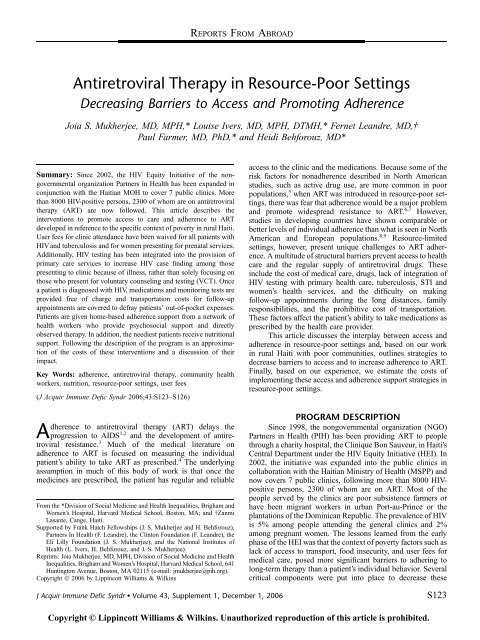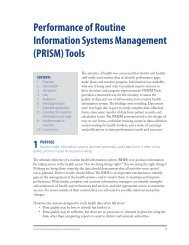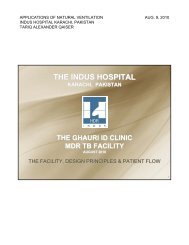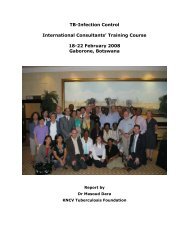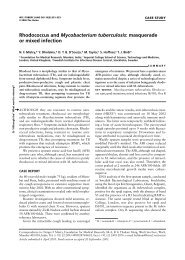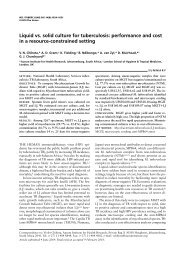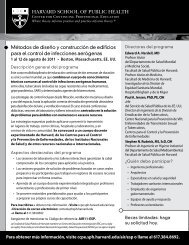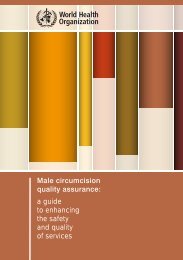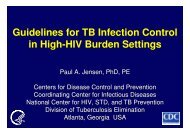Antiretroviral Therapy in Resource-Poor Settings - GiveWell
Antiretroviral Therapy in Resource-Poor Settings - GiveWell
Antiretroviral Therapy in Resource-Poor Settings - GiveWell
You also want an ePaper? Increase the reach of your titles
YUMPU automatically turns print PDFs into web optimized ePapers that Google loves.
REPORTS FROM ABROAD<br />
<strong>Antiretroviral</strong> <strong>Therapy</strong> <strong>in</strong> <strong>Resource</strong>-<strong>Poor</strong> Sett<strong>in</strong>gs<br />
Decreas<strong>in</strong>g Barriers to Access and Promot<strong>in</strong>g Adherence<br />
Joia S. Mukherjee, MD, MPH,* Louise Ivers, MD, MPH, DTMH,* Fernet Leandre, MD,†<br />
Paul Farmer, MD, PhD,* and Heidi Behforouz, MD*<br />
Summary: S<strong>in</strong>ce 2002, the HIV Equity Initiative of the nongovernmental<br />
organization Partners <strong>in</strong> Health has been expanded <strong>in</strong><br />
conjunction with the Haitian MOH to cover 7 public cl<strong>in</strong>ics. More<br />
than 8000 HIV-positive persons, 2300 of whom are on antiretroviral<br />
therapy (ART) are now followed. This article describes the<br />
<strong>in</strong>terventions to promote access to care and adherence to ART<br />
developed <strong>in</strong> reference to the specific context of poverty <strong>in</strong> rural Haiti.<br />
User fees for cl<strong>in</strong>ic attendance have been waived for all patients with<br />
HIV and tuberculosis and for women present<strong>in</strong>g for prenatal services.<br />
Additionally, HIV test<strong>in</strong>g has been <strong>in</strong>tegrated <strong>in</strong>to the provision of<br />
primary care services to <strong>in</strong>crease HIV case f<strong>in</strong>d<strong>in</strong>g among those<br />
present<strong>in</strong>g to cl<strong>in</strong>ic because of illness, rather than solely focus<strong>in</strong>g on<br />
those who present for voluntary counsel<strong>in</strong>g and test<strong>in</strong>g (VCT). Once<br />
a patient is diagnosed with HIV, medications and monitor<strong>in</strong>g tests are<br />
provided free of charge and transportation costs for follow-up<br />
appo<strong>in</strong>tments are covered to defray patients’ out-of-pocket expenses.<br />
Patients are given home-based adherence support from a network of<br />
health workers who provide psychosocial support and directly<br />
observed therapy. In addition, the neediest patients receive nutritional<br />
support. Follow<strong>in</strong>g the description of the program is an approximation<br />
of the costs of these <strong>in</strong>terventions and a discussion of their<br />
impact.<br />
Key Words: adherence, antiretroviral therapy, community health<br />
workers, nutrition, resource-poor sett<strong>in</strong>gs, user fees<br />
(J Acquir Immune Defic Syndr 2006;43:S123–S126)<br />
Adherence to antiretroviral therapy (ART) delays the<br />
progression to AIDS 1,2 and the development of antiretroviral<br />
resistance. 3 Much of the medical literature on<br />
adherence to ART is focused on measur<strong>in</strong>g the <strong>in</strong>dividual<br />
patient’s ability to take ART as prescribed. 4 The underly<strong>in</strong>g<br />
assumption <strong>in</strong> much of this body of work is that once the<br />
medic<strong>in</strong>es are prescribed, the patient has regular and reliable<br />
From the *Division of Social Medic<strong>in</strong>e and Health Inequalities, Brigham and<br />
Women’s Hospital, Harvard Medical School, Boston, MA; and †Zanmi<br />
Lasante, Cange, Haiti.<br />
Supported by Frank Hatch Fellowships (J. S. Mukherjee and H. Behforouz),<br />
Partners In Health (F. Leandre), the Cl<strong>in</strong>ton Foundation (F. Leandre), the<br />
Eli Lilly Foundation (J. S. Mukherjee), and the National Institutes of<br />
Health (L. Ivers, H. Behforouz, and J. S. Mukherjee).<br />
Repr<strong>in</strong>ts: Joia Mukherjee, MD, MPH, Division of Social Medic<strong>in</strong>e and Health<br />
Inequalities, Brigham and Women’s Hospital, Harvard Medical School, 641<br />
Hunt<strong>in</strong>gton Avenue, Boston, MA 02115 (e-mail: jmukherjee@pih.org).<br />
Copyright Ó 2006 by Lipp<strong>in</strong>cott Williams & Wilk<strong>in</strong>s<br />
access to the cl<strong>in</strong>ic and the medications. Because some of the<br />
risk factors for nonadherence described <strong>in</strong> North American<br />
studies, such as active drug use, are more common <strong>in</strong> poor<br />
populations, 5 when ART was <strong>in</strong>troduced <strong>in</strong> resource-poor sett<strong>in</strong>gs,<br />
there was fear that adherence would be a major problem<br />
and promote widespread resistance to ART. 6,7 However,<br />
studies <strong>in</strong> develop<strong>in</strong>g countries have shown comparable or<br />
better levels of <strong>in</strong>dividual adherence than what is seen <strong>in</strong> North<br />
American and European populations. 8,9 <strong>Resource</strong>-limited<br />
sett<strong>in</strong>gs, however, present unique challenges to ART adherence.<br />
A multitude of structural barriers prevent access to health<br />
care and the regular supply of antiretroviral drugs. These<br />
<strong>in</strong>clude the cost of medical care, drugs, lack of <strong>in</strong>tegration of<br />
HIV test<strong>in</strong>g with primary health care, tuberculosis, STI and<br />
women’s health services, and the difficulty on mak<strong>in</strong>g<br />
follow-up appo<strong>in</strong>tments dur<strong>in</strong>g the long distances, family<br />
responsibilities, and the prohibitive cost of transportation.<br />
These factors affect the patient’s ability to take medications as<br />
prescribed by the health care provider.<br />
This article discusses the <strong>in</strong>terplay between access and<br />
adherence <strong>in</strong> resource-poor sett<strong>in</strong>gs and, based on our work<br />
<strong>in</strong> rural Haiti with poor communities, outl<strong>in</strong>es strategies to<br />
decrease barriers to access and to <strong>in</strong>crease adherence to ART.<br />
F<strong>in</strong>ally, based on our experience, we estimate the costs of<br />
implement<strong>in</strong>g these access and adherence support strategies <strong>in</strong><br />
resource-poor sett<strong>in</strong>gs.<br />
PROGRAM DESCRIPTION<br />
S<strong>in</strong>ce 1998, the nongovernmental organization (NGO)<br />
Partners <strong>in</strong> Health (PIH) has been provid<strong>in</strong>g ART to people<br />
through a charity hospital, the Cl<strong>in</strong>ique Bon Sauveur, <strong>in</strong> Haiti’s<br />
Central Department under the HIV Equity Initiative (HEI). In<br />
2002, the <strong>in</strong>itiative was expanded <strong>in</strong>to the public cl<strong>in</strong>ics <strong>in</strong><br />
collaboration with the Haitian M<strong>in</strong>istry of Health (MSPP) and<br />
now covers 7 public cl<strong>in</strong>ics, follow<strong>in</strong>g more than 8000 HIVpositive<br />
persons, 2300 of whom are on ART. Most of the<br />
people served by the cl<strong>in</strong>ics are poor subsistence farmers or<br />
have been migrant workers <strong>in</strong> urban Port-au-Pr<strong>in</strong>ce or the<br />
plantations of the Dom<strong>in</strong>ican Republic. The prevalence of HIV<br />
is 5% among people attend<strong>in</strong>g the general cl<strong>in</strong>ics and 2%<br />
among pregnant women. The lessons learned from the early<br />
phase of the HEI was that the context of poverty factors such as<br />
lack of access to transport, food <strong>in</strong>security, and user fees for<br />
medical care, posed more significant barriers to adher<strong>in</strong>g to<br />
long-term therapy than a patient’s <strong>in</strong>dividual behavior. Several<br />
critical components were put <strong>in</strong>to place to decrease these<br />
J Acquir Immune Defic Syndr Volume 43, Supplement 1, December 1, 2006<br />
S123<br />
Copyright © Lipp<strong>in</strong>cott Williams & Wilk<strong>in</strong>s. Unauthorized reproduction of this article is prohibited.
Mukherjee et al J Acquir Immune Defic Syndr Volume 43, Supplement 1, December 1, 2006<br />
barriers. First, all services and medications are provided free of<br />
charge to the patient. It has been documented by several<br />
projects that user fees are a significant barrier to seek<strong>in</strong>g HIV<br />
test<strong>in</strong>g, obta<strong>in</strong><strong>in</strong>g laboratory evaluations, and attend<strong>in</strong>g<br />
follow-up appo<strong>in</strong>tments. 10 Such cost shar<strong>in</strong>g is detrimental<br />
to long-term adherence, as data from Senegal 11 and Botswana 9<br />
<strong>in</strong>dicate. In the HEI, user fees for services (visits and<br />
monitor<strong>in</strong>g) and all medications are waived entirely. All<br />
treatment is given free of charge (<strong>in</strong>clud<strong>in</strong>g not only ART but<br />
drugs for opportunistic <strong>in</strong>fections, family plann<strong>in</strong>g, and<br />
medications for other conditions such as hypertension).<br />
Second, HIV test<strong>in</strong>g, treatment, and care are provided <strong>in</strong><br />
the context of primary care services. This is particularly<br />
important and primary care cl<strong>in</strong>ics were revitalized by<br />
provid<strong>in</strong>g essential medic<strong>in</strong>es and pay<strong>in</strong>g stipends to MSPP<br />
staff <strong>in</strong> rural areas where patients rout<strong>in</strong>ely walk 4 or more<br />
hours to seek care. Most of the people attend<strong>in</strong>g the<br />
PIH/MSPP cl<strong>in</strong>ics come only when they are ill rather than<br />
to seek test<strong>in</strong>g for HIV per se. In the context of primary health<br />
care, ill patients are screened for tuberculosis, treatable causes<br />
of diarrheal disease, sexually transmitted diseases, and other<br />
conditions that may be associated with HIV. As part of the<br />
evaluation of the ill patient, HIV test<strong>in</strong>g may be offered by the<br />
cl<strong>in</strong>ician, if <strong>in</strong>dicated. This strategy, sometimes called ‘‘opt<br />
out’’ or ‘‘rout<strong>in</strong>e offer’’ HIV test<strong>in</strong>g, has been found to be<br />
acceptable <strong>in</strong> many sett<strong>in</strong>gs, particularly when ART is<br />
available. 12,13<br />
The third aspect of the program to <strong>in</strong>crease access and<br />
adherence to HIV treatment is an attempt to m<strong>in</strong>imize the<br />
significant out-of-pocket expenses. Studies from several<br />
sett<strong>in</strong>gs have shown that costs such as payment for transportation<br />
to and from a cl<strong>in</strong>ic serve as a deterrent to ART<br />
adherence. Patients attend<strong>in</strong>g PIH/MSPP cl<strong>in</strong>ic receive<br />
a monthly transportation stipend to attend follow-up appo<strong>in</strong>tments.<br />
Transportation for emergency visits is also covered by<br />
the program. 14 Similarly, a lack of food has been associated with<br />
poor adherence to ART, and provision of food and micronutrients<br />
has been shown to improve outcomes 15–17 Many<br />
families throughout the develop<strong>in</strong>g world spend more than 50%<br />
of their household <strong>in</strong>come on food, and food production and<br />
wage earn<strong>in</strong>g are adversely affected when an adult has<br />
AIDS. 18,19 Therefore, the PIH/MSPP program provides food<br />
or cash transfers for food to the most vulnerable patients.<br />
The fourth aspect of the HEI program to support adherence<br />
and m<strong>in</strong>imize barriers to access is the use of community<br />
health workers. Community health workers perform active<br />
case f<strong>in</strong>d<strong>in</strong>g for HIV and tuberculosis and provide a l<strong>in</strong>k<br />
between the patient, family, community, and cl<strong>in</strong>ic. Their daily<br />
role is to give psychologic support and directly observed<br />
FIGURE 1. VCT uptake with <strong>in</strong>troduction of HIV–primary health<br />
care <strong>in</strong>tegration: Lascahobas versus Cange. (From Walton D,<br />
Farmer P, Lambert W, et al. Integrated HIV prevention and care<br />
strengthens primary health care: lessons from rural Haiti.<br />
J Public Health Policy. 2004;25:137–158; with permission.)<br />
therapy to HIV patients requir<strong>in</strong>g ART. The development and<br />
activities of these workers have been described <strong>in</strong> detail<br />
elsewhere. 20,21<br />
RESULTS<br />
The Zamni Lasante proposal written to the Global Fund<br />
to Fight AIDS, Tuberculosis, and Malaria and, later, the<br />
President’s Emergency Plan for AIDS Relief <strong>in</strong>cluded the<br />
staff<strong>in</strong>g and essential medications that would be needed to<br />
<strong>in</strong>crease the provision of primary health services that would be<br />
expected for the population at each site. The improvement <strong>in</strong><br />
general health services, done with money for HIV scale-up,<br />
served to markedly <strong>in</strong>crease the utilization of primary health<br />
care. With this context, we presumed the uptake of HIV test<strong>in</strong>g<br />
would <strong>in</strong>crease.<br />
To discern whether or not the packages of <strong>in</strong>terventions<br />
described previously (discont<strong>in</strong>u<strong>in</strong>g user fees, <strong>in</strong>tegrat<strong>in</strong>g HIV<br />
test<strong>in</strong>g with primary health care, and provid<strong>in</strong>g transport fees<br />
and other material assistance to patients) <strong>in</strong>creased the overall<br />
uptake of HIV test<strong>in</strong>g and the use of health care services,<br />
records were analyzed from the Lascahobas MSPP cl<strong>in</strong>ic from<br />
the beg<strong>in</strong>n<strong>in</strong>g of the <strong>in</strong>tegrated PIH/MSPP program <strong>in</strong> October<br />
2002 through the end of 2003. The results of that analysis,<br />
which have been published elsewhere, 22 are seen <strong>in</strong> Figure 1.<br />
The number of VCT sessions at Lascahobas <strong>in</strong>creased<br />
dramatically after <strong>in</strong>itiation of the program and compares<br />
favorably with the rates reported from the referral center <strong>in</strong><br />
TABLE 1. Use of Services After the HIV–Primary Health Care Integrated Model of Care Was Implemented<br />
Public Cl<strong>in</strong>ic<br />
July 2002, Before MSPP–Zanmi<br />
Lasante Community Partnership<br />
Average No. Ambulatory Visits per Day<br />
December 2003, After Initiation of<br />
MSPP–Zanmi Lasante Community Partnership<br />
Average No. Ambulatory Visits per Day<br />
Lascahobas 20 400<br />
Belledere 10 150<br />
Thomonde 10 250<br />
Boucan Carre 10 250<br />
S124<br />
q 2006 Lipp<strong>in</strong>cott Williams & Wilk<strong>in</strong>s<br />
Copyright © Lipp<strong>in</strong>cott Williams & Wilk<strong>in</strong>s. Unauthorized reproduction of this article is prohibited.
J Acquir Immune Defic Syndr Volume 43, Supplement 1, December 1, 2006<br />
<strong>Antiretroviral</strong> <strong>Therapy</strong> <strong>in</strong> <strong>Resource</strong>-<strong>Poor</strong> Sett<strong>in</strong>gs<br />
TABLE 2. Approximate Costs of Adherence and Access Interventions <strong>in</strong> the PIH/MSPP HEI<br />
Intervention Cost ($US) per Patient per Year Description<br />
Waiv<strong>in</strong>g user fees $6 Monthly visits to cl<strong>in</strong>ic, normal user fee $0.05 per month 3 12 months<br />
Ancillary tests and monitor<strong>in</strong>g $20 Yearly CD4 cell count, radiographs, hemoglob<strong>in</strong>, liver function tests<br />
Transportation fees for monthly cl<strong>in</strong>ic visit $60 Monthly transport fee $5 per month 3 12 months<br />
Community health worker $100 Community health worker paid $500 per year for coverage of 5 patients<br />
Total $186<br />
Cange Cl<strong>in</strong>ique, Bon Sauveur, where HIV VCT and full<br />
primary health care services have been available s<strong>in</strong>ce 1986.<br />
With this series of <strong>in</strong>terventions, 40,000 HIV tests were<br />
performed <strong>in</strong> 2005. 2300 patients are on ART. Of the 1500<br />
patients who have been on ART for more than 1 year, fewer<br />
than 100 have died or had cl<strong>in</strong>ical or immunologic failure that<br />
required a change to second-l<strong>in</strong>e ART, suggest<strong>in</strong>g excellent<br />
adherence to ART and medical follow-up. Virologic monitor<strong>in</strong>g<br />
has not yet been performed <strong>in</strong> this population because of<br />
logistic and f<strong>in</strong>ancial barriers.<br />
Although there are many facets to the HEI adherence<br />
and access <strong>in</strong>terventions, some of the costs can be estimated.<br />
Table 2 outl<strong>in</strong>es the cost of the various <strong>in</strong>terventions. The<br />
transportation fee averages $60 US per patient per year. The<br />
cost of waiv<strong>in</strong>g the MSPP user fee for 12 monthly visits is $6<br />
US per patient per year. The cost of waiv<strong>in</strong>g the cost for<br />
ancillary tests (<strong>in</strong>clud<strong>in</strong>g a yearly CD4 cell count, radiographs,<br />
and rout<strong>in</strong>e laboratory monitor<strong>in</strong>g tests) is approximately $20<br />
US per year. This standard package adds up to approximately<br />
$86 US per year per patient. Community health workers are<br />
paid approximately $500 US per year and follow, on average, 5<br />
patients, add<strong>in</strong>g a cost of $100 US per patient per year. The<br />
total cost of the adherence package is $186 US per year.<br />
Patients who have severe wast<strong>in</strong>g and children with HIV<br />
who have signs of malnutrition receive nutritional support. We<br />
estimate that the cost of food for the patients who are<br />
economically and nutritionally the neediest is approximately<br />
$450 US per year. This <strong>in</strong>tervention is currently be<strong>in</strong>g<br />
evaluated <strong>in</strong> partnership with the World Food Program.<br />
DISCUSSION<br />
Scale-up of HIV test<strong>in</strong>g and treatment cannot be done<br />
without improv<strong>in</strong>g access to primary health care and<br />
<strong>in</strong>tegrat<strong>in</strong>g HIV services with that context. Moreover,<br />
adherence programs <strong>in</strong> resource-poor sett<strong>in</strong>gs must work to<br />
improve access to health care.<br />
The low rate of treatment failure, <strong>in</strong>dicated by few<br />
deaths and few patients need<strong>in</strong>g to change to second-l<strong>in</strong>e ART,<br />
suggests that adherence to medical follow-up and antiretroviral<br />
medication is excellent <strong>in</strong> the HEI. Monitor<strong>in</strong>g of virologic<br />
response and for the development of resistance with<strong>in</strong> the<br />
cohort of patients on ART is planned for this year. Additional<br />
work is planned to focus on measur<strong>in</strong>g the impact and cost of<br />
<strong>in</strong>dividual <strong>in</strong>terventions on cl<strong>in</strong>ic attendance and adherence. A<br />
first-l<strong>in</strong>e nevirap<strong>in</strong>e-based generic antiretroviral regimen costs<br />
approximately $150 US per person per year. Our basic<br />
package of support costs approximately $186 US. Investments<br />
<strong>in</strong> adherence, if effective, should yield a return <strong>in</strong> the form of<br />
q 2006 Lipp<strong>in</strong>cott Williams & Wilk<strong>in</strong>s<br />
a delay <strong>in</strong> the need for second-l<strong>in</strong>e ART. Second-l<strong>in</strong>e<br />
antiretroviral medications, typically lop<strong>in</strong>ivir/ritonovir, tenofovir,<br />
and abacavir, are not available as generic drugs and cost<br />
approximately $1500 US per patient per year. Thus, each year<br />
the need for a second-l<strong>in</strong>e regimen is delayed, $13,000 US is<br />
saved <strong>in</strong> antiretroviral costs. Additionally, patients are more<br />
likely to rema<strong>in</strong> healthy and out of the hospital if resistance is<br />
delayed.<br />
In the United States, where adherence support is not<br />
universal, approximately 50% of patients on a new antiretroviral<br />
regimen develop a detectable viral load (the precursor<br />
of resistance) at the end of 1 year, 23 but little has been done to<br />
provide f<strong>in</strong>ancial support for adherence programs.<br />
The challenge of adm<strong>in</strong>ister<strong>in</strong>g long-term therapy <strong>in</strong> sett<strong>in</strong>gs<br />
of extreme privation is significant. Although adherence<br />
to ART is much discussed <strong>in</strong> the public health arena, little has<br />
been done to advocate for f<strong>in</strong>ancial support of <strong>in</strong>itiatives that<br />
have been shown to improve adherence. HIV program should<br />
be rooted <strong>in</strong> sole primary health care to benefit a greater<br />
proportion of the community. HIV diagnosis, treatment, and<br />
monitor<strong>in</strong>g should be provided free of charge <strong>in</strong> poor<br />
communities to ensure that drugs are taken properly and not<br />
shared with family members or sold. Additionally, with the<br />
millions of dollars be<strong>in</strong>g <strong>in</strong>vested <strong>in</strong> the scale-up of ART,<br />
a lack of food security <strong>in</strong> the most heavily HIV-burdened<br />
countries threatens HIV programs and the health and survival<br />
of the most vulnerable.<br />
REFERENCES<br />
1. de Olalla PG, Knobel H, Carmona A, et al. Impact of adherence and<br />
highly active antiretroviral therapy on survival <strong>in</strong> HIV-<strong>in</strong>fected patients.<br />
J Acquir Immune Defic Syndr. 2002;30:105–110.<br />
2. Bangsberg DR, Perry S, Charlebois ED, et al. Non-adherence to highly<br />
active antiretroviral therapy predicts progression to AIDS. AIDS. 2001;15:<br />
1–2.<br />
3. Bangsberg D, Hecht F, Charlebois E, et al. Adherence to protease<br />
<strong>in</strong>hibitors, HIV-1 viral load and development of drug resistance <strong>in</strong> an<br />
<strong>in</strong>digent population. AIDS. 2000;14:357–366.<br />
4. Lucas GM, Chaisson RE, Moore RD. Highly active antiretroviral therapy<br />
<strong>in</strong> a large urban cl<strong>in</strong>ic: risk factors for virologic failure and adverse drug<br />
reactions. Ann Intern Med. 1999;131:81–87.<br />
5. Ste<strong>in</strong>er JF, Prochazka AV. The assessment of refill compliance us<strong>in</strong>g<br />
pharmacy records: methods, validity and applications. J Cl<strong>in</strong> Epi. 1997;<br />
50:105–116.<br />
6. Harries AD, Nyangulu DS, Hargreaves NJ, et al. Prevent<strong>in</strong>g antiretroviral<br />
anarchy <strong>in</strong> Africa. Lancet. 2001;358:410–414.<br />
7. Frater AJ, Dunn DT, Beardall AJ, et al. Comparative response of African<br />
HIV-1 <strong>in</strong>fected <strong>in</strong>dividuals to highly active antiretroviral therapy. AIDS.<br />
2002;16:1139–1146.<br />
8. Orrell C, Bangsberg DR, Badri M, et al. Adherence is not a barrier<br />
to successful antiretroviral therapy <strong>in</strong> South Africa. AIDS. 2003;17:<br />
1369–1375.<br />
S125<br />
Copyright © Lipp<strong>in</strong>cott Williams & Wilk<strong>in</strong>s. Unauthorized reproduction of this article is prohibited.
Mukherjee et al J Acquir Immune Defic Syndr Volume 43, Supplement 1, December 1, 2006<br />
9. Weiser S, Wolfe W, Bangsberg D, et al. Barriers to antiretroviral adherence<br />
for patients liv<strong>in</strong>g with HIV <strong>in</strong>fection and AIDS <strong>in</strong> Botswana. J Acquir<br />
Immune Defic Syndr. 2003;34:281–288.<br />
10. Russell S. The economic burden of illness for households <strong>in</strong> development<br />
countries: a review of the studies focus<strong>in</strong>g on malaria, tuberculosis and<br />
HIV/AIDS. Am J Trop Med Hyg. 2004;71(Suppl 2):147–155.<br />
11. Laniece I, Ciss M, Desclaux A, et al. Adherence to HAART and its<br />
pr<strong>in</strong>cipal determ<strong>in</strong>ants <strong>in</strong> a cohort of Senegalese adults. AIDS. 2003;17<br />
(Suppl 3):S103–S108.<br />
12. Centers for Disease Control. Introduction of rout<strong>in</strong>e HIV test<strong>in</strong>g <strong>in</strong><br />
prenatal care—Botswana, 2004. MMWR Morb Mort Wkly Rpt. 2004;53:<br />
1083–1086.<br />
13. Westheimer EF, Urassa W, Msamanga G, et al. Acceptance of HIV test<strong>in</strong>g<br />
among pregnant women <strong>in</strong> Dar-es-Salaam, Tanzania. J Acquir Immune<br />
Defic Syndr. 2004;37:1197–1205.<br />
14. Rowe KA, Makhubele B, Hargreaves JR, et al. Adherence to TB<br />
preventive therapy for HIV-positive patients <strong>in</strong> rural South Africa:<br />
implications for antiretroviral delivery <strong>in</strong> resource-poor sett<strong>in</strong>gs? Int J<br />
Tuberc Lung Dis. 2005;9:263–269.<br />
15. Ndekha MJ, Manary MJ, Ashorn P, et al. Home-based therapy with readyto-use<br />
therapeutic food is of benefit to malnourished, HIV-<strong>in</strong>fected<br />
Malawian children. Acta Paediatr. 2005;94:222–225.<br />
16. Villamor E, Saathoff E, Manji K, et al. Vitam<strong>in</strong> supplements,<br />
socioeconomic status, and morbidity events as predictors of wast<strong>in</strong>g<br />
<strong>in</strong> HIV-<strong>in</strong>fected women from Tanzania. Am J Cl<strong>in</strong> Nutr. 2005;82:<br />
857–865.<br />
17. Fawzi WW, Msamanga GI, Spiegelman D, et al. A randomized trial of<br />
multivitam<strong>in</strong> supplements and HIV disease progression and mortality. N<br />
Engl J Med. 2004;351:23–32.<br />
18. Rutengwe RM. Identify<strong>in</strong>g strategic <strong>in</strong>terventions for improv<strong>in</strong>g<br />
household food and nutrition security <strong>in</strong> an urban <strong>in</strong>formal<br />
settlement, South Africa. Asia Pac J Cl<strong>in</strong> Nutr. 2004;13(Suppl):<br />
S169.<br />
19. Smith Fawzi MC, Lambert W, S<strong>in</strong>gler JM, et al. Factors associated with<br />
forced sex among women <strong>in</strong> rural Haiti: implications for the prevention<br />
of HIV and other STDs. Soc Sci Med. 2005;60:679–689.<br />
20. Farmer P, Léandre F, Mukherjee JS, et al. Community-based<br />
approaches to HIV treatment <strong>in</strong> resource-poor sett<strong>in</strong>gs. Lancet. 2001;<br />
358:404–409.<br />
21. Farmer P, Léandre F, Mukherjee JS, et al. Community-based approaches to<br />
the treatment of advanced HIV disease, <strong>in</strong>troduc<strong>in</strong>g DOT-HAART. Bull<br />
World Health Organ. 2001;79:1145–1151.<br />
22. Walton D, Farmer P, Lambert W, et al. Integrated HIV prevention and care<br />
strengthens primary health care: lessons from rural Haiti. J Public Health<br />
Policy. 2004;25:137–158.<br />
23. Gross R, Bilker WB, Friedman HM, et al. Effect of adherence to newly<br />
<strong>in</strong>itiated antiretroviral therapy on plasma viral load. AIDS. 2001;15:<br />
2109–2111.<br />
S126<br />
q 2006 Lipp<strong>in</strong>cott Williams & Wilk<strong>in</strong>s<br />
Copyright © Lipp<strong>in</strong>cott Williams & Wilk<strong>in</strong>s. Unauthorized reproduction of this article is prohibited.


